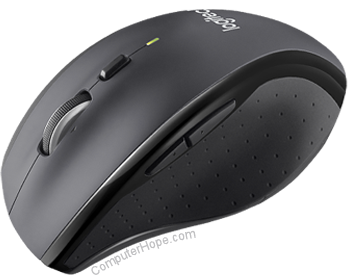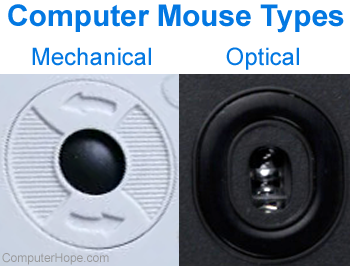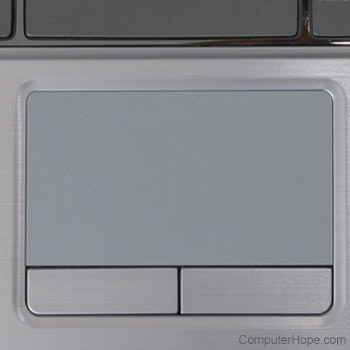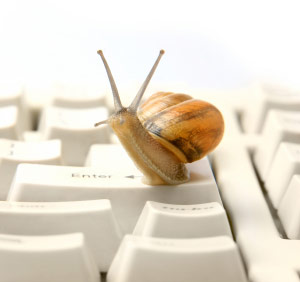how to fix a mouse
Mouse acting erratically, jumping, or is not moving properly
Updated: 06/30/2020 by Computer Hope

If the cursor on your screen moves erratically when you move the mouse, the following steps may help you fix the problem.
The mouse is not clean
An optical-mechanical mouse (mouse with a ball) may not work well because the inside of the mouse is not clean. See our computer cleaning page for steps to remedy this problem.
The optical portion of the mouse is blocked

If you have an optical mouse (LED or laser) with erratic behavior, the optical eye may be blocked. Hair or fuzz can block the sensor on the bottom of the mouse, preventing the optical sensor from working correctly. Turn the mouse over and make sure there is no debris blocking the hole. Blowing into the hole usually removes any hair or fuzz that could cause problems.
Bad surface
Although most mice work on any surface, if you're having problems, use a different mouse pad or surface, such as a book or piece of paper. For example, optical mice are notorious for not working on glossy surfaces. Putting a piece a paper under the mouse is a quick fix for this issue.
Wireless mouse
If you have a wireless mouse, there can be several reasons why your mouse may be jumping.
Bad wireless connection
To communicate wirelessly with the computer, your mouse must have a strong signal between the computer and the mouse. Make sure your mouse is no more than a few feet away from the wireless receiver. If the USB receiver has a short cable, move it to the front of the computer to get a better signal.
Bad or failing batteries
Bad or failing batteries can also cause low signal strength with wireless mice. Try replacing the batteries or making sure they are charged to see if the batteries are causing the issue.
Wireless signal interference

As with any wireless device, wireless mouse signals are susceptible to RFI (radio frequency interference). Depending on where the wireless receiver is located, other device signals may interfere with signals from the mouse to the receiver. A wireless router, keyboard, headset, cordless phones, and other devices transmit and receive signals that could interfere with the mouse signals.
Electrical interference is also possible. Some computer monitors, and even hardware in a computer, can give off electrical signals that interfere with a wireless mouse. For example, if the monitor is not properly shielded or malfunctioning, it can release electrical signals that may scramble or break up the signals from a wireless mouse. The same concept applies to computer hardware, especially a power supply.
It is also possible for EMI (electromagnetic interference) to cause issues with a wireless mouse. If a device with a magnet is near the wireless receiver or mouse, it can cause interference that results in erratic mouse behavior.
For all of these types of interference, the solution is to determine which device is causing the interference. Try moving that device to another location that is farther away from the mouse. If it receives and transmits wireless signals to its receiver, try moving the device or receiver. If you find the computer monitor is causing the problem, replace the monitor, as it should not be generating an interfering signal and is likely defective. The same is true if the computer power supply is causing the interference; its best to replace it.
Reconnect and try a different port
It is possible that a loose connection or bad port can cause problems with the mouse. Make sure that it's not either of these problems by disconnecting the mouse from the current USB port and connecting to another USB port.
If you are using an older computer with a PS/2 mouse, try disconnecting the mouse and reconnecting the mouse into the mouse port (usually the green port). If your computer has USB ports, you may also want to consider upgrading to a USB mouse.
Moisture or a liquid substance on finger

If you're using a touchpad, you may experience erratic behavior because of moisture or a liquid substance on your finger, such as lotion or soap. Wash your hands and wipe them with a towel thoroughly to remove any lotion, soap, or other oily substances from your fingers. It may also help to clean off the touchpad itself to remove any substances on the touchpad.
- Laptop touchpad cursor jumps around while not touching it.
Disconnect other external input devices
If you have other input devices, such as another external mouse, graphics tablet, or keypad, connected to your computer, it may cause interference. Try disconnecting these devices to make sure they are not causing the problem.
Update drivers and uninstall older drivers
Because drivers control how the mouse interfaces with the operating system, if the drivers are bad, the mouse is not going to work properly. Make sure you have the latest drivers from your mouse manufacturer.
- How to install and update a computer driver.
We also recommend going into Add or Remove Programs (also called "Programs and Features" in newer versions of Windows) in the Control Panel and uninstalling all previous mouse drivers and software. Uninstalling old software is important when moving between mouse manufacturers, like going from a Logitech to a Microsoft mouse.
- How to uninstall software in Windows.
Underperforming computer

If the mouse cursor only acts erratically or jumps around while playing a video game, the computer may not have enough RAM or video memory. If this is the case, it can result in reduced functionality of the mouse. If the graphics card in the computer is underpowered, the video game often experiences graphics lag. The mouse cursor also can jump around instead of having smooth motion across the screen because the computer cannot display graphics properly.
Review the recommended hardware requirements for the game, especially those about the RAM and video memory. If your computer has the bare minimum requirements or does not meet the requirements, you need to upgrade its hardware.
- How to find how much RAM is installed on a computer.
- What type of computer memory to use in a memory upgrade?
- Can I upgrade the video memory on my video card?
- How to install a computer video card.
Defective mouse
If you have followed all of the troubleshooting options above and continue to encounter problems, the mouse is likely defective. To determine if this is the case, try connecting the mouse to another computer. You can also try connecting a different mouse to your computer. If your mouse does not work with another computer or another mouse does work on your computer, we suggest replacing the mouse.
Corrupt operating system files or virus infection

If, after trying everything above, you're still having problems with your mouse, and another mouse doesn't work either, there may be corrupt operating system files on your computer. If one or more system files that interact with the mouse are corrupt, this can cause erratic mouse movement or failure to respond and click in various cases. If possible, restoring to a previous restore point before the problem started to occur could resolve the issue. However, you may have to perform an operating system repair install or full system recovery to resolve this type of issue.
- How to restore Windows to an earlier copy.
- How to automatically repair problems in Windows.
- How to erase my hard drive and start over.
Computer virus or malware could also cause problems with mouse movement and clicking actions, and other problems. Scan your computer with an antivirus program to determine if it's infected.
- What are the currently available antivirus programs?
- Where can I find free online virus scanners?
Defective motherboard

If you've tried all the steps above, the PS/2 or USB connections on the motherboard may be defective. In this case, the motherboard needs to be replaced. We suggest taking your computer to a repair shop because of the difficulty of replacing a motherboard.
If you want to replace the motherboard, purchase the same model of the motherboard as currently in your computer. If you decide to purchase a different model, do your research and make sure it is compatible with all your existing hardware.
Note
If you purchase a new, different model motherboard than what is currently in the computer, you may need to reinstall Windows due to the change in hardware. Windows has drivers installed that are specific to each motherboard, and changing the motherboard causes different drivers to be needed for Windows to run correctly.
- How do I remove a computer motherboard?
- Computer motherboard buying tips.
how to fix a mouse
Source: https://www.computerhope.com/issues/ch000253.htm
Posted by: watersfrilyin.blogspot.com

0 Response to "how to fix a mouse"
Post a Comment